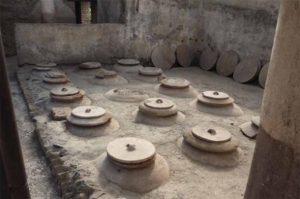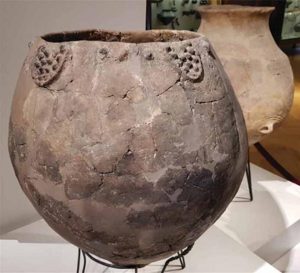Warm Bread and Almonds: The Key to Complex Roman Wine Unveiled

Of the many cultural and physical remnants left behind by the Romans, along with everlasting concrete, a love of wine also endures. When the Roman poet Horace contemplates death, he was more concerned about parting from his wine cellar than his wife. Now, a new study showing the kind of high-quality wines produced by the Romans might explain that adoration. The discovery of an especially fine, amber-colored wine, with aromas of walnuts and spice, along with an estimated alcohol content of about 11 percent, is one such variety!
Roman Dolia: Nuanced Flavor and Sophistication in Winemaking
The recent study by researchers from Ghent University, analyzing Roman dolia (large clay jars used for winemaking), provides an understanding into the flavor profile of ancient Roman wine. According to their analysis, it is suggested that Roman wine had a ‘slightly spicy’ flavor, accompanied by aromas of toasted bread and walnuts.

Heavily Seasoned: Why did the Ancients Like Salty Wine?
8,000-year-old Residue in the Middle East is the Earliest Evidence Yet of Winemaking
Buried Roman fermentation jars (dolia) from Villa Regina, Boscoreale. (E. Dodd, courtesy of the Ministero della Cultura – Parco Archaeologico di Pompei/Antiquity Publications Ltd)
The fact that the Romans were able to produce wines with such nuanced flavors suggests a level of expertise and sophistication in their winemaking techniques. The use of dolia, or clay jars, as winemaking vessels, and the comparison to modern qvevri in Georgia, reveal similarities in shaping practices between ancient and contemporary wine cultures. These finds have been published in the latest edition of Antiquity.
“No study has yet scrutinized the role of these earthenware vessels in Roman winemaking and their impact on the look, smell and taste of ancient wines”, the authors, led by Dr. Dimitri Van Limbergen, said.
Winemaking in qvevri and dolia is both straightforward and an ingenious method for producing wine: large wine cellars filled with dolia represented investments, and could only occur under economically favorable circumstances, indicating economic prosperity in the Roman world during Late Republican and Early Imperial times.
Simultaneously, many households could afford one dolium, and winemaking likely constituted a part of daily life in numerous families. This made wine a product consumed across a broad social scale, similar to the situation in many households today in Georgia where they make their own wine and store it next to the kitchen or in a cellar inside a qvevri.
These findings align with the broader historical and literary evidence that emphasizes the importance of wine in various aspects of Roman life, from daily consumption to religious rituals. The Romans had a deep appreciation for wine, and it played a central role in their social and cultural practices.
“The value of identifying, often unexpected, parallels between modern and ancient winemaking lies in both debunking the alleged amateurish nature of Roman winemaking and uncovering common traits in millennia-old vinification procedures,” Dr. Van Limbergen said in the study.

Example of an ancient Georgian spherical winemaking vessel from c. 6000BC. (D. Van Limbergen, courtesy of Georgian National Museum/Antiquity Publications Ltd)
A Keen Sense of Deliberation: Precise Engineering of Flavor
One significant difference highlighted in the study is the porosity of the ancient Roman clay vessels compared to the sealed, stainless-steel tanks used in modern wine production. The porous nature of dolia allows for oxygen exposure throughout the fermentation process, in contrast to the sealed environment of steel tanks, reports The Times.
Dr. Van Limbergen argues that the Roman use of dolia sheds light on an important step in ancient Roman winemaking known as “maceration.” According to his analysis, the use of dolia indicates that maceration – where grape skins sit in the fermenting juice – played a crucial role in Roman winemaking practices.
Maceration is a process that involves allowing the grape skins to remain in contact with the grape juice during fermentation. This process is common in red wine production and contributes to the extraction of color, tannins, and flavor compounds from the grape skins. However, Van Limbergen suggests that the use of maceration in Roman winemaking may have been applied to white grapes as well, resulting in a rich amber color for the wines produced.
This exposure to oxygen contributed to the richness and complexity of the wine, introducing flavors such as roasted nuts and bruised apples. The mineral-rich clay likely added a drying sensation to the wine.
“By burying the dolia in the ground, temperature and pH could be controlled, encouraging the formation of surface yeasts and a chemical compound called sotolon,” the study reveals. “This gives wine a slightly spicy flavor with aromas of toasted bread and walnuts.”
The discovery of varying sizes and shapes of storage containers from the Roman period suggests that ancient winemakers were cognizant of different techniques to manipulate the flavor profile of their wines. This variability in storage containers indicates that the Romans had substantial control over the winemaking process and were actively experimenting with different methods to achieve desired flavors, reports The Daily Mail.
“Far from being mundane storage vessels, dolia were precisely engineered containers whose composition, size and shape all contributed to the successful production of diverse wines with specific organoleptic characteristics,” the researchers concluded.